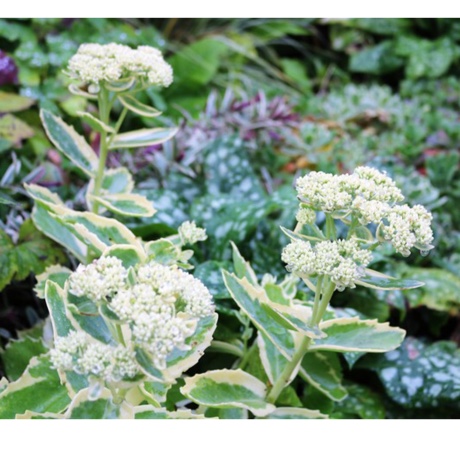
Hylotelephium Erythrostictum v. Frosty Morn
Hylotelephium 'Frosty Morn'
http://www.crassulaceae.ch/de/artikel?akID=66&aaID=2&aiID=E&aID=3506 = H. erythrostictum cv Introduced from Japan by Barry Yinger. Sedum erythrostictum Miquel (1866) Sedum alboroseum Baker (1868) / Sedum telephium ssp. alboroseum (Baker) Fröderström (1930) Sedum erythrostictum var. variegatum Masters (1878) / Sedum erythrostictum fa. variegatum (Masters) Hara (1952) Sedum labordei H.Leveillé & Vaniot (1914) Sedum okuyamae Ohwi (1949) Section Hylotelephium Distribution : Japan, Korea, eastern China. Description (according to IHSP, 2003) : Flowering stems erect, glaucous, 30 - 100 cm, with thickening rootstock and roots. Leaves altemate or opposite, shortly petiolate, elliptic-ovate to elliptic, 6 - 10 x 2 - 4 cm, pale green, glabrous, tip obtuse, base attenuate, margins serrate. Inflorescences corymb-like, semiglobose. Flowers : Sepals triangular, ± 1.5 mm, petals pink, elliptic-Ianceolate,5 - 6 mm, anthers purplish-red. Flowering time : September to October. Cytology : 2n = 48, 50 (Uhl & Moran 1972) There are two variegated forms : - A form with a white / cream / yellowish blotch in the centre of the leaf > H. erythrostictum fa. foliis medio-variegatis, Regel > Hylotelephium erythrostictum 'Mediovariegatum' - A form with a border of greenish-white > H. erythrostictum fa. foliis margine-variegatis > Hylotelephium 'Frosty Morn'
Contributed by @gardentagssucculentexpert
-
Full sun to partial shade
-
Frequent watering
-
A little frost hardy: 32F (0°C)
-
Free draining and fertile
Common name
Hylotelephium 'Frosty Morn'
Latin name
Hylotelephium Erythrostictum v. Frosty Morn
type
Perennial
family
Crassulaceae
ph
6.0 - 7.5 Acid - Neutral
Plant & bloom calendar
-
Best time to plant
-
When the plant will bloom
full grown dimensions
 0.40 M
0.40 M
0.40 M
0.40 M
Hylotelephium Erythrostictum v. Frosty Morn
http://www.crassulaceae.ch/de/artikel?akID=66&aaID=2&aiID=E&aID=3506 = H. erythrostictum cv Introduced from Japan by Barry Yinger. Sedum erythrostictum Miquel (1866) Sedum alboroseum Baker (1868) / Sedum telephium ssp. alboroseum (Baker) Fröderström (1930) Sedum erythrostictum var. variegatum Masters (1878) / Sedum erythrostictum fa. variegatum (Masters) Hara (1952) Sedum labordei H.Leveillé & Vaniot (1914) Sedum okuyamae Ohwi (1949) Section Hylotelephium Distribution : Japan, Korea, eastern China. Description (according to IHSP, 2003) : Flowering stems erect, glaucous, 30 - 100 cm, with thickening rootstock and roots. Leaves altemate or opposite, shortly petiolate, elliptic-ovate to elliptic, 6 - 10 x 2 - 4 cm, pale green, glabrous, tip obtuse, base attenuate, margins serrate. Inflorescences corymb-like, semiglobose. Flowers : Sepals triangular, ± 1.5 mm, petals pink, elliptic-Ianceolate,5 - 6 mm, anthers purplish-red. Flowering time : September to October. Cytology : 2n = 48, 50 (Uhl & Moran 1972) There are two variegated forms : - A form with a white / cream / yellowish blotch in the centre of the leaf > H. erythrostictum fa. foliis medio-variegatis, Regel > Hylotelephium erythrostictum 'Mediovariegatum' - A form with a border of greenish-white > H. erythrostictum fa. foliis margine-variegatis > Hylotelephium 'Frosty Morn'
Flowering
From Mid Summer TO Mid Autumn
Most sedum flower through the summer months and into early Autumn
Planting
From Early Spring TO Mid Spring
Plant divisions or seeds in Spring
Propagating by seed
From Early Spring TO Mid Spring
Sow seeds in Spring
Propagating by division
From Mid Spring TO Late Summer
Dividing plants for propagation can be done at any time during the growing season, and divisions will grow readily.











